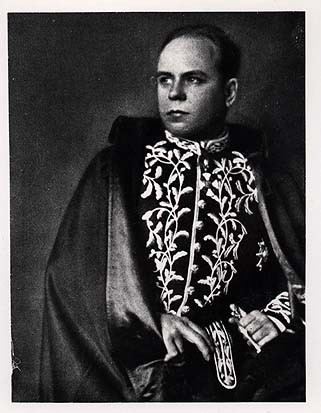 | ||
The Royal Academy of Italy (Italian: Reale Accademia d'Italia) was an organization of Italian academians, intellectuals, and cultural figures created on 7 January 1926 by the Fascist government of the Kingdom of Italy by a royal decree, and effectively dissolved in 1943.
Contents
The declared purpose of the academy was "to promote and coordinate Italian intellectual activity in the sciences, the humanities, and the arts, to preserve the integrity of the national spirit, according to the genius and tradition of the race, and to encourage their diffusion [abroad]".
Structure and history
The Academy was modelled upon the prestigious French Academy. The Academy selected sixty Italians chosen for their scientific, literary, and artistic achievements. Those sixty members were divided into four groups of fifteen, representing the physical sciences, moral sciences (including history), arts, and letters (literature).
Politically the Academy served to unify and strengthen the Fascist regime's hold on intellectual activity in Italy, as the Academy demanded that all its members swear loyalty to Fascism and Italy. The Academy was effective at drawing in the intellectual and cultural elites, and was mostly effective at rewarding real talent rather than just loyalty to the regime. It absorbed other independent institutions, notably the prestigious and venerable scientific Accademia dei Lincei in 1939.
The members were well paid, earning 3,000 lire per month at a time when average per capita income in Italy was 3,079 per year. The members were automatically granted first class travel on Italy's national railroads and were entitled to wear uniforms designed for the members and to be addressed as "Your Excellency". Each were allowed to compete for the four annual Mussolini prizes which were awarded to Academy members who demonstrated outstanding work in their respective fields. The Academy sponsored lectures, meetings, research, and publications. In 1934, the Academy appointed a commission to create a dictionary of the Italian language in which all Italianized foreign words were to be removed.
After the collapse of the Fascist regime in 1943 and the installation of the puppet Fascist regime in the Italian Social Republic, a new version of the Academy was briefly reopened until the remnant Fascist state was defeated in 1945. The heir to the Royal Academy of Italy is the Angelica-Constantiniana Academy of Arts and Sciences, established in 1949.
Notable members
The Academy's presidents included:
The following figures were among the first members named by Mussolini in 1929: Antonio Beltramelli, Pietro Bonfante, Filippo Bottazzi, Armando Brasini, Pietro Canonica, Francesco Coppola, Giotto Dainelli, Salvatore Di Giacomo, Enrico Fermi, Carlo Formichi, Umberto Giordano, Alessandro Luzio, Antonio Mancini, Filippo Tommaso Marinetti, Pietro Mascagni, Francesco Orestano, Alfredo Panzini, Nicola Parravano, Marcello Piacentini, Luigi Pirandello, Pietro Romualdo Pirotta, Ettore Romagnoli, Romano Romanelli, Giulio Aristide Sartorio, Francesco Severi, Bonaldo Stringher, Alfredo Trombetti, Giancarlo Vallauri, Gioacchino Volpe, and Adolfo Wildt.
